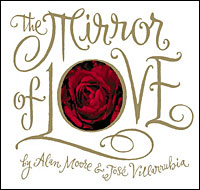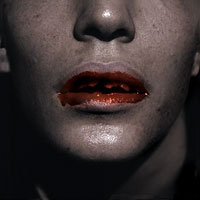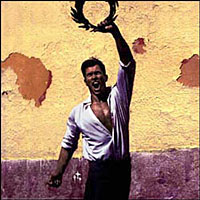>> Top Nine: Wheeler's Choice
>> Comment: 'San Diego', To The Tune Of 'Desperado'
More...

"Behind the interlocking shields of war."
What do you call a book that's written by a comic writer, illustrated by a comic artist, and published by a comic publisher, but isn't a comic? In the case of THE MIRROR OF LOVE, you call it a work of art.
THE MIRROR OF LOVE is a poem by Alan Moore, illustrated by Jose Villarrubia. It started out as a dialogue in AARGH, a one-off publication from Alan Moore's long-defunct Mad Love publishing imprint. AARGH, or 'Artists Against Rampant Government Homophobia', was created in 1988 in response to Section 28 of that year's Local Government Act, a homophobic piece of legislation introduced by Britain's Thatcher government, which stated:
"A local authority shall not intentionally promote homosexuality or publish material with the intention of promoting homosexuality; or promote the teaching in any maintained school of the acceptability of homosexuality as a pretended family relationship."
The aim of the legislation was to protect children from a perceived homosexual agenda. It was essentially toothless from the start, partly because local authorities had no authority over what was taught in schools, and partly because the perceived threat simply did not exist, so no prosecutions were ever made. Yet the law remained in place until November 17th of last year, a bogeyman to teachers, and a legal enshrinement of the notion that homosexuality was a "pretend family relationship".
With AARGH, Moore rallied his friends and colleagues, including Art Spiegelman, Frank Miller, Neil Gaiman, Robert Crumb and Dave Sim, to produce a response to Clause 28 that would help raise money to fight for the clause's abolition. AARGH has long been out of print, and copies are extremely hard to find, but Moore's own contribution is now back in print thanks to Top Shelf. Much of the credit goes to Jose Villarrubia, however, as it was he who steered the project into being, and its his stunning photography that provides the illustrations for the new volume.
"Yet should this love, this faith, pure joys afford."
THE MIRROR OF LOVE is a history of same-sex love, beginning with the first life on Earth and ending - inevitably, for the time of its writing - with the use of homosexuality as a scapegoat for the AIDS crisis. Along the way it touches on Shakespeare, Sappho, the Spartans, Christian persecution and the Holocaust.
 It's an eloquent, affectionate and deeply passionate work. While the sort of minds that could create something like Clause 28 hide behind supposedly high-principled rhetoric while pushing an agenda of hate, Moore demonstrates that the best way to answer back is with an agenda of love. Moore is a writer of tremendous empathy and sincerity, and in his hands, love is the most convincing argument ever made. Moore's words are at once both enormously stirring, yet weighted with the strength of reason. He has love, logic, and imagination on his side, leaving his opponents with nothing more than vendettas and vitriol.
It's an eloquent, affectionate and deeply passionate work. While the sort of minds that could create something like Clause 28 hide behind supposedly high-principled rhetoric while pushing an agenda of hate, Moore demonstrates that the best way to answer back is with an agenda of love. Moore is a writer of tremendous empathy and sincerity, and in his hands, love is the most convincing argument ever made. Moore's words are at once both enormously stirring, yet weighted with the strength of reason. He has love, logic, and imagination on his side, leaving his opponents with nothing more than vendettas and vitriol.
In Villarrubia's photography, Moore's words find their perfect companion. Villarrubia has been very careful to put together images that complement the text, rather than drowning it out. In fact, many of the images are conspicuously simple, and their significance only becomes clear when placed in the context of the poem. Others are vibrant and powerful enough to stand alone, and when combined with the words, the impact can be extraordinary.
THE MIRROR OF LOVE isn't comics, but it's as powerful an example as you'll find of what the synthesis of words and pictures can achieve.
"We grew, but in obscurity."
At a launch event for THE MIRROR OF LOVE in London two weeks ago, Jose Villarrubia gave a talk on the history of homosexuality in comics. It's a familiar theme for me, as I've written on the subject several times in the past. I've also had rewarding conversations with several creators on the subject.
Yet as well as I know the subject, I found I was surprised by Villarrubia's presentation. Seeing various images of gay-themed characters and comics from across the years projected onto a screen was a depressing experience. The images spoke of shame, and of missed opportunities, and they never once seemed to speak of progress. Villarrubia's talk was excellent, but the conclusion was bleak; the history of homosexuality in comics boils down to three ages of obscurity, each separated by a lengthy silence.
 There was the coded age of early superheroes like BATMAN, Bob Kane's caped pederast. Whether this subtext was intended or not, the possibility of coded homosexuality being a subject fit for comics was conclusively stamped upon by Dr Fredric Wertham's calls for comics censorship and the Kefauver congressional hearings into juvenile delinquency in 1954.
There was the coded age of early superheroes like BATMAN, Bob Kane's caped pederast. Whether this subtext was intended or not, the possibility of coded homosexuality being a subject fit for comics was conclusively stamped upon by Dr Fredric Wertham's calls for comics censorship and the Kefauver congressional hearings into juvenile delinquency in 1954.
Then there was the underground age, almost thirty years later, which was dominated by Howard Cruse with both his WENDEL strip in the Advocate and that lonely and infrequent anthology series GAY COMIX.
It would be nice to say that the underground gay comic has been a constant presence ever since, but gay themes remain seldom explored even by independent creators. Creators like Donna Barr, Tim Barela and Roberta Gregory have been carrying the banner in a sparse formation for too long, and are only now being joined by the likes of Jai Sen, Elizabeth Watasin and Tim Fish.
And then there's the modern age of the victim, exemplified by Judd Winick's well-intentioned GREEN LANTERN and Mark Millar's AUTHORITY, where homosexuality is allowed to feature so long as it can be used for a story about abuse. There's also Ron Zimmerman's RAWHIDE KID, where the entire reading audience was the victim.
"And I marched as I loved, my dear, with thee."
In a sense, gay audiences have never had it so good. At least now gay themes are getting some coverage from the major publishers, even if it is largely restricted to old stereotypes and Very Special Episodes, with physical affection still conveniently restricted to the gutters of the page, and the actual subject of sex never mentioned, even when there's far kinkier things going on behind closed doors at Avengers Mansion.
 Yes, you could call all of this a progress of sorts. Certainly when I wrote on this site three years ago that there needed to be more homosexual characters in comics, I didn't have these stories to refer to. But this wasn't what I was asking for, and I'm not going to be reticent about asking for more.
Yes, you could call all of this a progress of sorts. Certainly when I wrote on this site three years ago that there needed to be more homosexual characters in comics, I didn't have these stories to refer to. But this wasn't what I was asking for, and I'm not going to be reticent about asking for more.
I wanted to see gay stories, yes - of the sort told by Jai Sen, Elizabeth Watasin, Tim Fish et al, rather than the sort told by Ron Zimmerman - but what I wanted most was equal treatment and equal representation, and that hasn't changed.
To get there from here, gay characters and storylines may have to seem like a novelty for a while. We'll know we've got to the right place when the novelty's worn off, and not because people have put the gay characters back in the box, feeling they've filled the quota or responded to the fashion, but because the homosexuals are there in the everyday, just as they are in your office or church or school.
Publishers like Marvel and DC have made minor concessions in the past few years, but they seem to do it with so little enthusiasm that I have to assume they do it only to appease their more liberal-minded heavy hitting creators.
Of course, it's not the job of comics publishers to advance the social agenda, and while there may be money to be made from it, there's a lot of risk that goes with that territory as well. It would be nice to believe that publishers could be conscientious, that they could want to represent their readers and provide positive reinforcement, and that they could believe in the potential of their medium to powerful, intelligent and progressive, but there's no reason to expect that they do.
So perhaps it falls solely to the creators to push for equality in their art. Yet it's hard to find politics in the work of today's comic authors, even in an age of war and atrocity, and harder still to imagine something like AARGH being put together today.
But it would be harder still to accept that as an answer and stop asking.

This article is Ideological Freeware. The author grants permission for its reproduction and redistribution by private individuals on condition that the author and source of the article are clearly shown, no charge is made, and the whole article is reproduced intact, including this notice.


